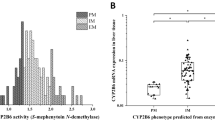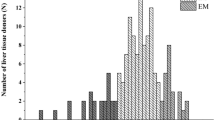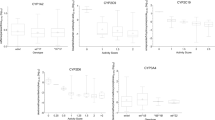ABSTRACT
The present study investigated the effect of cytochrome P450 2C9 (CYP2C9) genetic polymorphism on the biotransformation of valproic acid (VPA) to its hepatotoxic metabolite, 4-ene-VPA, and compared that to the formation of the inactive 4-OH-VPA and 5-OH-VPA. cDNA-expressed CYP2C9*2 and CYP2C9*3 variants were less efficient than the CYP2C9*1 wild type in catalyzing the formation of these metabolites, as assessed by the ratio of Vmax and apparent Km (in vitro intrinsic clearance). The reduced efficiency by CYP2C9*2 was due to a reduced Vmax, whereas, in the case of CYP2C9*3, it was the result of increased apparent Km. The formation rates of 4-ene-VPA, 4-OH-VPA, and 5-OH-VPA in human liver microsomes were reduced by 29, 28, and 31%, respectively, in samples with one mutated CYP2C9 allele, and by 61, 73, and 58%, respectively, in samples with two mutated CYP2C9 alleles. Overall, the homozygote and heterozygote CYP2C9*2 and CYP2C9*3 genotypes may compromise hepatic VPA biotransformation.
This is a preview of subscription content, access via your institution
Access options
Subscribe to this journal
Receive 6 print issues and online access
$259.00 per year
only $43.17 per issue
Buy this article
- Purchase on Springer Link
- Instant access to full article PDF
Prices may be subject to local taxes which are calculated during checkout





Similar content being viewed by others
References
Loscher W . Valproate: a reappraisal of its pharmacodynamic properties and mechanisms of action. Prog Neurobiol 1999; 58: 31–59.
Stephens JR, Levy RH . Valproate hepatotoxicity syndrome: hypothesis of pathogenesis. Pharm Weekbl Sci 1992; 14: 118–121.
Davis R, Peters DH, McTavish D . Valproic acid—a reappraisal of its pharmacological properties and clinical efficacy in epilepsy. Drugs 1994; 47: 332–372.
Abbott FS, Anari MR . Chemistry and biotransformation. In: Loscher W (ed). Milestones in Drug Therapy. Birkhauser Verlag: Valproate, Basel 1999; pp 47–75.
Klose TS, Blaisdell JA, Goldstein JA . Gene structure of CYP2C8 and extrahepatic distribution of the human CYP2Cs. J Biochem Mol Toxicol 1999; 13: 289–295.
Veronese ME, MacKenzie PI, Doecke CJ, McManus ME, Miners JO, Birkett DJ . Tolbutamide and phenytoin hydroxylations by cDNA-expressed human liver cytochrome P450 2C9. Biochem Biophys Res Commun 1991; 175: 1112–1118.
Relling MV, Aoyama T, Gonzalez FJ, Meyer UA . Tolbutamide and mephenytoin hydroxylation by human cytochrome P450s in the CYP2C subfamily. J Pharmacol Exp Ther 1990; 252: 442–447.
Rettie AE, Korzekwa KR, Kunze KL, Lawrence RF, Eddy AC, Aoyama T et al. Hydroxylation of warfarin by human cDNA-expressed cytochrome P-450: a role for P-450 2C9 in the etiology of (S)-warfarin drug interactions. Chem Res Toxicol 1992; 5: 54–59.
Chang TKH, Yu L, Maurel P, Waxman DJ . Enhanced cyclophosphamide and ifosfamide activation in primary human hepatocyte cultures: response to cytochrome P-450 inducers and autoinduction by oxazaphosphorines. Cancer Res 1997; 57: 1946–1954.
Miners JO, Birkett DJ . Use of tolbutamide as a substrate probe for human hepatic cytochrome P450 2C9. Methods Enzymol 1996; 272: 139–145.
Hamman MA, Thompson GA, Hall SD . Regioselective and stereoselective metabolism of ibuprofen by human cytochrome P450 2C. Biochem Pharmacol 1997; 54: 33–41.
Takahashi H, Echizen H . Pharmacogenetics of warfarin elimination and its clinical implications. Clin Pharmacokinet 2001; 40: 587–603.
Dickmann LJ, Rettie AE, Kneller MB, Kim RB, Wood AJJ, Stein CM et al. Identification and functional characterization of a new CYP2C9 variant (CYP2C9*5) expressed among African-Americans. Mol Pharmacol 2001; 60: 382–387.
Kidd RS, Curry TB, Gallagher S, Edeki T, Blaisdell J, Goldstein JA . Identification of a null allele of CYP2C9 in an African-American exhibiting toxicity to phenytoin. Pharmacogenetics 2001; 11: 803–808.
Lee CR, Goldstein JA, Pieper JA . Cytochrome P450 2C9 polymorphisms: a comprehensive review of the in-vitro and human data. Pharmacogenetics 2003; 12: 251–263.
Takanashi K, Tainaka H, Kobayashi K, Yasumori T, Hosakawa M, Chiba K . CYP2C9 Ile359 and Leu359 variants: enzyme kinetic study with seven substrates. Pharmacogenetics 2000; 10: 95–104.
Sadeque AJM, Fisher MB, Korzekwa KR, Gonzalez FJ, Rettie AE . Human CYP2C9 and CYP2A6 mediate formation of the hepatotoxin 4-ene-valproic acid. J Pharmacol Exp Ther 1997; 283: 698–703.
Sullivan-Klose TH, Ghanayem BI, Bell DA, Zhang ZY, Kaminsky LS, Shenfield GM et al. The role of the CYP2C9-Leu359 allelic variant in the tolbutamide polymorphism. Pharmacogenetics 1996; 6: 341–349.
Tang C, Shou M, Rushmore TH, Mei Q, Sandhu P, Woolf EJ et al. In-vitro metabolism of celecoxib, a cyclooxygenase-2 inhibitor, by allelic variant forms of human liver microsomal cytochrome P450 2C9: correlation with CYP2C9 genotype and in-vivo pharmacokinetics. Pharmacogenetics 2001; 11: 223–235.
Gotoh O . Substrate recognition sites in cytochrome P450 family 2 (CYP2) proteins inferred from comparative analyses of amino acid and coding nucleotide sequences. J Biol Chem 1992; 267: 83–90.
Crespi CL, Miller VP . The R144C change in the CYP2C9*2 allele alters interaction of the cytochrome P450 with NADPH:cytochrome P450 oxidoreductase. Pharmacogenetics 1997; 7: 203–210.
Steward DJ, Haining RL, Henne KR, Davis G, Rushmore TH, Trager WF et al. Genetic association between sensitivity to warfarin and expression of CYP2C9*3. Pharmacogenetics 1997; 7: 361–367.
Takahashi H, Kashima T, Nomoto S, Iwade K, Tainaka H, Shimizu T et al. Comparisons between in-vitro and in-vivo metabolism of (S)-warfarin: catalytic activities of cDNA-expressed CYP2C9, its Leu359 variant and their mixture versus unbound clearance in patients with the corresponding CYP2C9 genotypes. Pharmacogenetics 1998; 8: 365–373.
Kidd RS, Straughn AB, Meyer MC, Blaisdell J, Goldstein JA, Dalton JT . Pharmacokinetics of chlorpheniramine, phenytoin, glipizide and nifedipine in an individual homozygous for the CYP2C9*3 allele. Pharmacogenetics 1999; 9: 71–80.
Brandolese R, Scordo MG, Spina E, Gusella M, Padrini R . Severe phenytoin intoxication in a subject homozygous for CYP2C9*3. Clin Pharmacol Ther 2001; 70: 391–394.
Scordo MG, Aklillu E, Yasar U, Dahl ML, Spina E, Ingelman-Sundberg M . Genetic polymorphism of cytochrome P450 2C9 in a Caucasian and a black African population. Br J Clin Pharmacol 2001; 52: 447–450.
Aynacioglu AS, Brockmoller J, Bauer S, Sachse C, Guzelbey P, Ongen Z et al. Frequency of cytochrome P450 2C9 variants in a Turkish population and functional relevance for phenytoin. Br J Clin Pharmacol 1999; 48: 409–415.
van der Weide J, Steijns LSW, van Weelden MJM, de Haan K . The effect of genetic polymorphism of cytochrome P450 CYP2C9 on phenytoin dose requirement. Pharmacogenetics 2001; 11: 287–291.
Shimamoto J, Ieiri I, Urae A, Kimura M, Irie S, Kubota T et al. Lack of differences in diclofenac (a substrate for CYP2C9) pharmacokinetics in healthy volunteers with respect to the single CYP2C9*3 allele. Eur J Clin Pharmacol 2000; 56: 65–68.
Yasar U, Eliasson E, Forslund-Bergengren C, Tybring G, Gadd M, Sjoqvist F et al. The role of CYP2C9 genotype in the metabolism of diclofenac in vivo and in vitro. Eur J Clin Pharmacol 2001; 57: 729–735.
Brenner SS, Herrlinger C, Dilger K, Murdter TE, Hofmann U, Marx C et al. Influence of age and cytochrome P450 2C9 genotype on the steady-state disposition of diclofenac and celecoxib. Clin Pharmacokinet 2003; 42: 283–292.
Kirchheiner J, Meineke I, Steinbach N, Meisel C, Roots I, Brockmoller J . Pharmacokinetics of diclofenac and inhibition of cyclooxygenase 1 and 2: no relationship to the CYP2C9 genetic polymorphism in humans. Br J Clin Pharmacol 2003; 55: 51–61.
Gill HJ, Tjia JF, Kitteringham NR, Pirmohamed M, Back DJ, Park BK . The effect of genetic polymorphisms in CYP2C9 on sulphamethoxazole N-hydroxylation. Pharmacogenetics 1999; 9: 43–53.
Anari MR, Burton RW, Gopaul S, Abbott FS . Metabolic profiling of valproic acid by cDNA-expressed human cytochrome P450 enzymes using negative-ion chemical ionization gas chromatography-mass spectrophotometry. J Chromatogr 2000; 742: 217–227.
Levy RH . Cytochrome P450 isozymes and antiepileptic drug interactions. Epilepsia 1995; 36(Suppl 5): S8–S13.
Zheng JJ Metabolism and pharmacokinetic studies of valproic acid using stable isotope techniques, M.Sc. Thesis. The University of British Columbia: Vancouver 1993.
Lang T, Klein K, Fischer J, Nussler AK, Neuhaus P, Hofmann U et al. Extensive genetic polymorphism in the human CYP2B6 gene with impact on expression and function in human liver. Pharmacogenetics 2001; 11: 399–415.
Coller JK, Krebsfaenger N, Klein K, Endrizzi K, Wolbold R, Lang T et al. The influence of CYP2B6, CYP2C9, and CYP2D6 genotypes on the formation of the potent antiestrogen Z-4-hydroxy-tamoxifen in human liver. Br J Clin Pharmacol 2002; 54: 157–167.
Acknowledgements
We thank Vincent Tong for his assistance. This research was supported by Grant MOP-13744 (to FSA and TKHC) from the Canadian Institutes of Health Research. TKHC received a Research Career Award in the Health Sciences from the Canadian Institutes of Health Research and the Rx&D Health Research Foundation.
Author information
Authors and Affiliations
Corresponding author
Additional information
DUALITY OF INTEREST
None declared.
Rights and permissions
About this article
Cite this article
Ho, P., Abbott, F., Zanger, U. et al. Influence of CYP2C9 genotypes on the formation of a hepatotoxic metabolite of valproic acid in human liver microsomes. Pharmacogenomics J 3, 335–342 (2003). https://doi.org/10.1038/sj.tpj.6500210
Received:
Revised:
Accepted:
Published:
Issue Date:
DOI: https://doi.org/10.1038/sj.tpj.6500210
Keywords
This article is cited by
-
PAMAM-G4 protect the N-(2-hydroxyphenyl)-2-propylpentanamide (HO-AAVPA) and maintain its antiproliferative effects on MCF-7
Scientific Reports (2023)
-
Impact of genetic and non-genetic factors on hepatic CYP2C9 expression and activity in Hungarian subjects
Scientific Reports (2021)
-
Human Family 1–4 cytochrome P450 enzymes involved in the metabolic activation of xenobiotic and physiological chemicals: an update
Archives of Toxicology (2021)
-
Influence of CYP2C9 and CYP2A6 on plasma concentrations of valproic acid: a meta-analysis
European Journal of Clinical Pharmacology (2020)
-
Estimation of apparent clearance of valproic acid in adult Saudi patients
International Journal of Clinical Pharmacy (2019)



